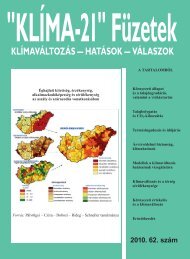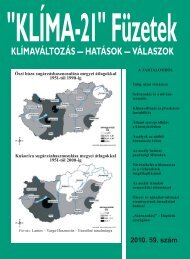KLÃMA-21 Füzetek 61. szám - VAHAVA Hálózat
KLÃMA-21 Füzetek 61. szám - VAHAVA Hálózat
KLÃMA-21 Füzetek 61. szám - VAHAVA Hálózat
You also want an ePaper? Increase the reach of your titles
YUMPU automatically turns print PDFs into web optimized ePapers that Google loves.
194 „KLÍMA-<strong>21</strong>” FÜZETEK: KLÍMAVÁLTOZÁS – HATÁSOK – VÁLASZOK<br />
CLIMATE CHANGE – LESSONS FOR SOIL TILLAGE<br />
AND THE CONDITION OF SOIL<br />
By<br />
BIRKÁS, MÁRTA – SZEMŐK, ANDRÁS – MESIĆ, MILAN<br />
Keywords: soil tillage, the condition of soil,<br />
climate-induced stress, climate damage mitigation.<br />
The relationship between soil quality factors and climatic effects were studied in long term<br />
tillage experiments and by field monitoring. The goal of researchers is to provide scientific<br />
proof for the problems encountered in practice and to offer recommendations on making<br />
crop growing more reliable under extreme climate conditions. This will change the region’s<br />
prevailing tillage practices radically, including the abandonment of all methods that are detrimental<br />
to the soil and environment alike. In line with the requirements of landscape and<br />
environment protection, tillage is nowadays aimed at maintaining favourable soil quality and<br />
fertility and at preventing adverse changes such as climate sensitiveness.<br />
One of the most important results of the soil quality research is the identification of tillage<br />
practices that are detrimental to the soil. The most important techniques used in the Pannonian<br />
region which fall into this category include: 1. Deep stubble stripping in the summer,<br />
leaving exposed soil surface without surface forming or coverage. 2. Ploughing in the summer,<br />
leaving soil surface without surface cover. 3. Shallow disking when the soil is compacted<br />
below the disked layer. 4. Winter ploughing of wet soil, which creates or thickens the plough<br />
pan. 5. Leaving soil surface after winter ploughing without surface forming when there is<br />
no (site-specific or other) reason for doing so. 6. Failing to loosen the root zone that has been<br />
compacted by tillage. 7. Reducing the quality of primary winter tillage by using tools that are<br />
not suitable for the soil moisture content. 8. Reducing the looseness of primary tillage at seedbed<br />
preparation (creating thick seedbed base). 9. Making decisions concerning tillage for the<br />
next crop without knowledge of the status of the soil. 10. Using irrigation techniques without<br />
knowledge of the sensitiveness of soil.<br />
Driven by the need to reduce climate stress, regional soil tillage scientists joined forces<br />
to help improve tillage practices on the basis of their scientific achievements. Their recommendations<br />
are as follows: 1. The first step is to reduce the climate risks of summer soil tillage<br />
operations. 2. As tillage-induced soil state issues increase the damage caused by drought<br />
and water-logging, information on soil conditions is needed to draw conclusions concerning<br />
the likely damage. 3. Preventing the development of compact layers which impede water<br />
transport, and eliminating compact layers in the soil through appropriate tillage techniques.<br />
4. Covering the surface with crushed stubble residue to protect soil and moisture and to<br />
decrease heat and rain stress in critical periods. 5. Creating a small surface area at any time<br />
of the season, without compaction stress. 6. Protecting the soil structure, irrespective of the<br />
tillage method. 7. Preserving the organic matter content of the soil is crucial for climate stress<br />
mitigation. 8. Adapting any type of tillage method which improves the condition of soil. 9.<br />
Causing less stress in over wet or dry soils. 10. Maintaining the soil’s capacity to take in and<br />
to store water in irrigated soils. Tillage methods which preserve the water and carbon content<br />
and the structure of soil are crucial in irrigated soils.






